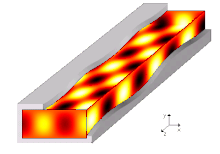

A waveguide is a structure that guides waves by restricting the transmission of energy to one direction. Common types of waveguides include acoustic waveguides which direct sound, optical waveguides which direct light, and radio-frequency waveguides which direct electromagnetic waves other than light like radio waves.
Without the physical constraint of a waveguide, waves would expand into three-dimensional space and their intensities would decrease according to the inverse square law.
There are different types of waveguides for different types of waves. The original and most common meaning is a hollow conductive metal pipe used to carry high frequency radio waves, particularly microwaves.[1] Dielectric waveguides are used at higher radio frequencies, and transparent dielectric waveguides and optical fibers serve as waveguides for light. In acoustics, air ducts and horns are used as waveguides for sound in musical instruments and loudspeakers, and specially-shaped metal rods conduct ultrasonic waves in ultrasonic machining.
The geometry of a waveguide reflects its function; in addition to more common types that channel the wave in one dimension, there are two-dimensional slab waveguides which confine waves to two dimensions. The frequency of the transmitted wave also dictates the size of a waveguide: each waveguide has a cutoff wavelength determined by its size and will not conduct waves of greater wavelength; an optical fiber that guides light will not transmit microwaves which have a much larger wavelength. Some naturally occurring structures can also act as waveguides. The SOFAR channel layer in the ocean can guide the sound of whale song across enormous distances.[2] Any shape of cross section of waveguide can support EM waves. Irregular shapes are difficult to analyse. Commonly used waveguides are rectangular and circular in shape.